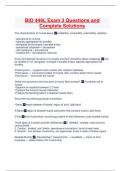BIO 446L Exam 3 Questions and
Complete Solutions
The characteristics of muscle tissue ✅excitability, contractility, extensibility, elasticity
- specialized to contract
- typically aggregated into bundles
- elongated and arranged in parallel arrays
- specialized cytoplasm = sarcoplasm
- cell membrane = sarcolemma
- modified ER = sarcoplasmic reticulum
Know the histologic structure of a muscle and their connective tissue wrappings ✅Can
be striated or not, elongated, arranged in parallel arrays, typically aggregated into
bundles
-Endomysium → supports each muscle cell, contains capillaries
-Perimysium → surrounds bundles of muscle cells, contains larger blood vessels
-Epimysium → surrounds the muscle
Define the sarcomere and how does a muscle fiber contract? ✅-functional unit of
muscle
-Segment of myofibrils between 2 Z-lines
-Contains the A-band (myosin filaments)
-Produce the banding pattern in skeletal muscle fibers
Sarcomere shortening produces contraction
I-Band ✅region between A-bands, region of actin, light band
A-Band ✅region of striated muscle sarcomere that contains myosin, dark band
Z-line ✅end of sarcomere; anchoring proteins of actin filaments; cross-striated muscle
Three types of muscles and their differences ✅1. Skeletal - striated, most common,
cannot divide
2. Cardiac - striated, can't divide, spontaneous contraction, found in/near heart
3. Smooth - non-striated, involuntary, can regenerate, found in walls of hollow organs
Skeletal Muscle ✅- Development: mesenchyme → myoblasts → fusion to form
myotubes → differentiation into muscle fiber
, - Characteristics: Parallel striated muscle cells (fibers), Multinucleated cell b/c of fusion
of myotubes, Peripherally located nuclei, limited regeneration from isolated satellite
cells, Has a tendon (collagenous fibers) to attach to bone, Rich blood supply
- Neuromotor unit - neuron and muscle cells
Smooth Muscle ✅characteristics --> Non-striated, Spontaneously active
Involuntary, Exhibits "tone" (always contracting to some degree), Can regenerate,
Ellipsoid nucleus = corkscrew when contracted, Myofilaments arranged in many planes
and anchored to plasma membrane
commonly found --> in the walls of hollow organs (blood and lymph vessels, digestive
tract, excretory ducts, tracheobronchial tree, urogenital ducts, uterus), individualized
muscles (arrector pili muscles of hairs, constrictor and dilator muscles of the iris, ciliary
muscles)
Specialized smooth muscle cells = myoepithelial cells found in exocrine glands (salivary
glands, mammary glands)
Cardiac Muscle ✅- Mononucleated cells, not fused, 3-D branching and interdigitation
of cells
- Smaller cell than skeletal muscle, with central nucleus
- Striated myofibrils composed of sarcomeres
- Do NOT divide and have NO satellite cells
- Have intercalated discus (special cross bands) interconnect muscle cells via gap
junctions that allow all cells to excite if just one does
- More capillaries than skeletal muscle
- Spontaneous contraction initiated by pacemaker cells
- Organized into nodes and specialized conducting fibers
- Anatomy → intercalated discs with desmosomes and gap junctions
neuromuscular junction ✅point of contact between a motor neuron and a skeletal
muscle cell
- neurotransmitter = acetylcholine
5 steps:
1. Nerve impulse triggers release of Ach from synaptic bulb into synaptic cleft. Ach
binds to Ach receptors in the motor end plate of the neuromuscular junction, initiating a
muscle impulse in the sarcolemma of the muscle fiber
2. As the muscle impulse spreads quickly from the sarcolemma along T tubules, Ca2+
ions are released from terminal cisternae (TC) into the sarcoplasm
3. Ca2+ ions bind to the troponin which changes shape, moving tropomyosin on the
actin to expose active sites on actin molecules of thin filaments. Myosin heads of thick
filaments attach to exposed active sites to form crossbridges
4. Myosin heads pivot, moving thin filaments toward the sarcomere center. ATP binds
myosin heads and is broken down into ADP and Pi. Myosin heads detach from thin
filaments and return to their pre-pivot position. The repeating cycle of attach-pivot-




